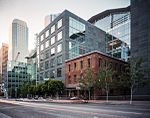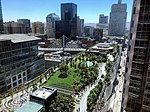33 Tehama

33 Tehama is a luxury residential apartment complex in the South of Market neighborhood in San Francisco, California. The building is 380 feet (120 m) tall, 35 stories, and contains 403 residential units. Groundbreaking was in mid-2015, and construction finished in 2018. The building is part of the San Francisco Transbay development area around the Transbay Transit Center site in the South of Market neighborhood. The building was developed by Hines and Invesco Real Estate. Lendlease was the general contractor. Due to repeated incidents of flooding on the 35th floor, the building was closed indefinitely to all tenants on June 3, 2022. It was initially not expected to reopen until early 2023; However, as of October 11, 2023 (over a year since the building was closed), the building still has not reopened to the public.
Excerpt from the Wikipedia article 33 Tehama (License: CC BY-SA 3.0, Authors, Images).33 Tehama
Tehama Street, San Francisco
Geographical coordinates (GPS) Address Website External links Nearby Places Show on map
Geographical coordinates (GPS)
| Latitude | Longitude |
|---|---|
| N 37.7873 ° | E -122.3962 ° |
Address
33 Tehama
Tehama Street 33;41
94105 San Francisco
California, United States
Open on Google Maps









